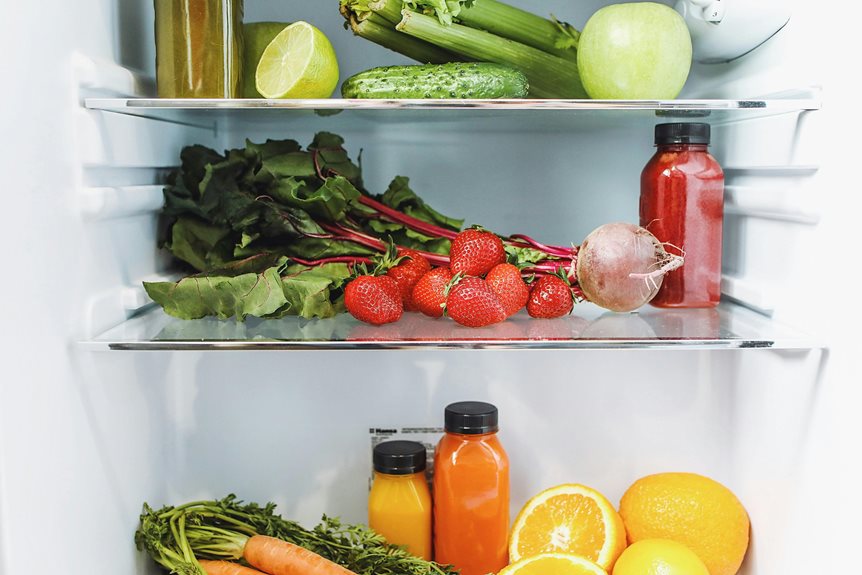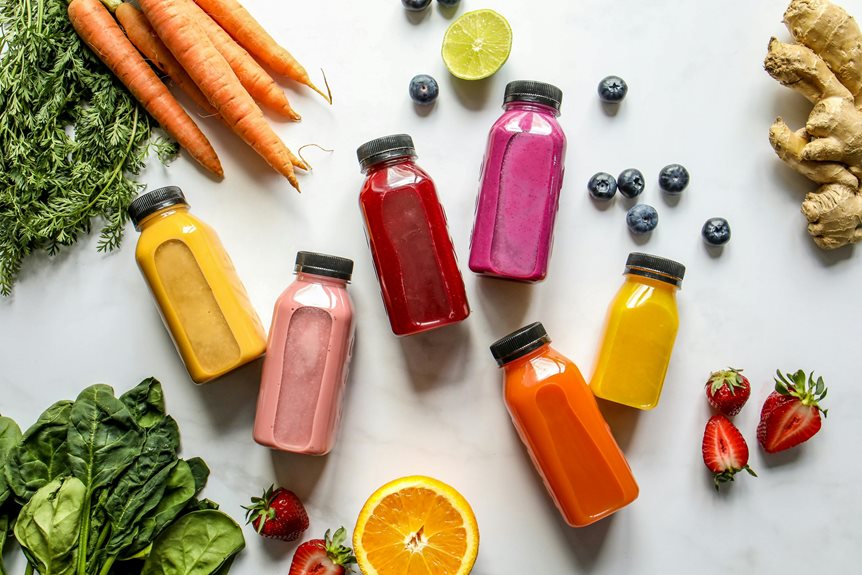To make perfect beet juice, you’ll want to select firm, unwrinkled beets with bright leaves attached, preferably organic varieties. Start by thoroughly cleaning and cutting your beets into uniform pieces. Set up your juicer in a clean workspace, ensuring all components are properly assembled. Feed the beets slowly through your juicer, alternating with complementary ingredients for better flow. Strain the juice, add a splash of lemon, and store properly in an airtight container. Master these fundamentals, and you’ll discover even more ways to enhance your beet juice experience.
Selecting and Sourcing Fresh Quality Beets
Selecting the right beets is essential for creating delicious, nutrient-rich juice. Choose varieties known for their sweetness, such as Golden Detroit, Touchstone Gold, or Detroit Dark Red beets. Baby and golden beets offer milder flavors with less earthiness, making them ideal for juicing beginners.
When shopping, look for firm, unwrinkled beets with bright green leaves still attached. Select smaller beets for maximum sweetness, and always opt for organic to avoid pesticides. You’ll find the best quality beets at local farmers’ markets or organic grocery stores during peak season. If you’re ambitious, grow your own for the freshest possible produce. The vitamin-rich greens can be juiced alongside the beets for added calcium and nutrients.
Store your beets properly by keeping them unwashed in a cool, dark place, with roots and greens separated. Use them within a few days to guarantee peak flavor and nutrition.
Essential Preparation and Cleaning Steps
Before diving into the juicing process, proper preparation and cleaning of your beets will guarantee both safety and ideal flavor.
Start by soaking your beets in water and scrubbing them thoroughly with a vegetable brush to remove all dirt and debris.
Next, trim off the leaves and stems, which you can save for other recipes. While some methods allow for unpeeled beets, you’ll get the cleanest taste by removing the skin.
Cut your beets into uniform pieces that’ll fit through your juicer easily. If you’re using a blender method, grate them with a box grater instead.
Remember to strain your juice through a fine-mesh strainer or cheesecloth to achieve the smoothest result.
For optimal extraction and nutrition, using an Omega slow-press juicer will provide the best results.
Add a teaspoon of lemon juice to preserve freshness, and always handle beet juice carefully as it can permanently stain surfaces.
Setting Up Your Equipment and Workspace
With your beets cleaned and prepped, it’s time to set up your juicing station. Choose a cold press or masticating juicer for ideal nutrient preservation, ensuring it has a wide chute to minimize your prep work. Brands like Breville, Optimum, and AICOK offer reliable options. The Optimum 600XXL juicer is particularly effective for beetroot processing.
Assemble your juicer according to the manufacturer’s instructions, making sure all components are clean and securely fitted. Position your juice collection cup under the spout, and keep a waste container nearby for pulp disposal. For those looking to juice wheatgrass, it’s important to use a dedicated wheatgrass juicer because regular vegetable juicers are unsuitable for handling the fibrous nature of wheatgrass.
Clear your workspace of obstacles and arrange your pre-cut ingredients in batches for efficient processing. If you’re using a high-performing motor, you’ll process beets quickly.
Keep cleaning supplies within reach for immediate cleanup, and have a refrigerator ready to chill your finished juice.
Mastering the Perfect Juicing Technique
Once you’ve set up your juicing station, mastering the proper technique guarantees maximum juice yield and nutrient extraction from your beets. Spinach is another great addition to your juicing routine, offering a mild flavor and a rich nutritional profile that complements beets well. Start by thoroughly washing and peeling your beets, then cut them into small chunks or thin strips. For ideal results using a juicer, alternate feeding beets with other ingredients like carrots or cucumbers to prevent clogging. Apply steady, gentle pressure to the chute while juicing.
If you’re using a blender, combine your chopped beets with water and blend for 2-3 minutes until smooth. Strain the mixture through a cheesecloth, pressing firmly with a spoon to extract every drop.
For both methods, enhance the flavor with a pinch of pink salt and fresh lemon juice. The recommended ratio of ingredients is 4 parts apple, 4 parts carrot, 2 parts orange, and 1 part beet. Serve immediately or store in the refrigerator for up to one day.
Enhancing Flavor With Complementary Ingredients
Although beets offer impressive health benefits, their strong earthy flavor can be overwhelming on its own. You’ll want to maintain a 3:1 veggie-to-fruit ratio while strategically incorporating flavor enhancers to create a balanced juice.
Start by adding bright citrus fruits like orange or grapefruit to lighten the earthiness. You can intensify the citrus notes with a teaspoon of zest or a squeeze of lemon.
For additional complexity, include herbs and spices: ginger (1/4 inch knob), basil (3-5 leaves), or mint (5-10 leaves) work exceptionally well. Don’t forget to incorporate sweet vegetables like carrots to balance the flavor profile. These combinations provide rich vitamins and minerals that support overall wellness. Juices like beetroot juice not only enhance flavor but also contribute to lowering total plasma cholesterol, which is beneficial for heart health.
For an extra flavor boost, try adding 1/4 cup pineapple or a pinch of cardamom. A tiny dash of sea salt will help reduce any metallic aftertaste while enhancing the overall taste.
Maximizing Nutritional Benefits
Because the nutritional content of beetroot juice depends heavily on proper selection and preparation, maximizing its benefits requires careful attention to detail.
You’ll get the most nutrients by choosing firm, unwrinkled beets with bright green leaves attached, preferably organic to avoid pesticides. Beetroot juice is known for its high nitrate content, which the body converts into nitric oxide, aiding in the relaxation and dilation of blood vessels.
To preserve essential compounds like betalains, nitrates, and antioxidants, opt for a cold press juicer rather than a centrifugal model. The cold press method prevents heat and oxidation from destroying these valuable nutrients. Regular consumption can help lower blood pressure naturally through its high nitrate content.
If you’re using a blender instead, strain the mixture through cheesecloth to achieve a smooth consistency.
Keep the skin on during preparation to retain more fiber, and thoroughly clean your beets under cold running water.
This approach guarantees you’ll capture the full spectrum of vitamins and minerals, including iron, magnesium, potassium, and folate.
Proper Storage and Serving Methods
Properly storing your freshly made beet juice guarantees you’ll preserve its nutritional value and prevent spoilage.
Store your juice immediately in an airtight glass container, leaving an inch of headspace, and place it in the coldest part of your refrigerator at 40°F (4°C) or below.
Choose dark or opaque containers to protect against light exposure, or store the juice in a dark section of your fridge.
You’ll want to consume your juice within 48 hours for best freshness and nutrition.
Monitor for signs of spoilage by checking the color, smell, and taste – fresh beet juice should maintain its vibrant color and earthy aroma.
If you notice any browning, off-odors, or bubbles forming, it’s time to discard the juice.
Always label your container with the juicing date to track freshness.
Adding a splash of fresh lemon juice can help extend the shelf life of your beet juice naturally.




Konnichiwa! (Hello!) I'm Pat Tokuyama, a Japanese tofu cookbook author, who travels for music, food, and adventure. If you like Japanese tea, checkout some of the newestorganic japanese tea, matcha bowls and noren and more!
** Curious about the Plant Based Japanese Cooking Club? ** Learn more here!